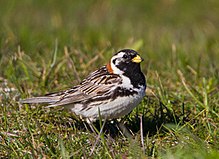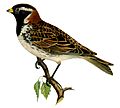Lapland longspur
| Lapland longspur | |
|---|---|

| |
| Male | |
| Scientific classification | |
| Domain: | Eukaryota |
| Kingdom: | Animalia |
| Phylum: | Chordata |
| Class: | Aves |
| Order: | Passeriformes |
| Family: | Calcariidae |
| Genus: | Calcarius |
| Species: | C. lapponicus
|
| Binomial name | |
| Calcarius lapponicus (Linnaeus, 1758)
| |

| |
| Range Breeding Migration Nonbreeding
| |
| Synonyms | |
|
Fringilla lapponica Linnaeus, 1758 | |
The Lapland longspur (Calcarius lapponicus), also known as the Lapland bunting, is a passerine bird in the longspur family Calcariidae, a group separated by most modern authors from the Fringillidae (Old World finches).
Taxonomy
[edit]The Lapland longspur was formally described in 1758 by the Swedish naturalist Carl Linnaeus in the tenth edition of his Systema Naturae. He placed it with the finches in the genus Fringilla and coined the binomial name Fringilla lapponica.[2][3] The Lapland longspur is now one of three longspurs placed in the genus Calcarius that was introduced in 1802 by the German naturalist Johann Matthäus Bechstein.[4] The English name refers to the long hind claws.[5] The genus name Calcarius is from Latin calcaria, "spurs", and the specific lapponicus refers to Lapland.[6]
Five subspecies are recognised:[4]
- C. l. subcalcaratus (Brehm, CL, 1826) – north Canada and Greenland
- C. l. lapponicus (Linnaeus, 1758) – north Europe and north Asia
- C. l. kamtschaticus Portenko, 1937 – northeast Siberia
- C. l. alascensis Ridgway, 1898 – extreme east Siberia, Alaska and northwest Canada
- C. l. coloratus Ridgway, 1898 – Commander Islands
Description
[edit]The Lapland longspur is a robust bird, with a thick yellow seed-eater's bill. The summer male has a black head and throat, white eyestripe, chestnut nape, white underparts, and a heavily streaked black-grey back. Other plumages have a plainer orange-brown head, a browner back and chestnut nape and wing panels.
Measurements:[7]
- Length: 5.9–6.3 in (15–16 cm)
- Weight: 0.8–1.2 oz (22.3–33.1 g)
- Wingspan: 8.7–11.4 in (22–29 cm)
Distribution and habitat
[edit]It breeds across Arctic Europe and the Palearctic and in Canada and the northernmost United States. It is migratory, wintering in the Russian steppes, the southern United States, Northern Scandinavian arctic areas and down to coastal Southern Sweden, Denmark and Great Britain. This is the only Asian species of the longspur buntings, and while it probably did not evolve there, it has been present in Eastern Europe for at least about 30,000 years.[8]
Behaviour
[edit]Call
[edit]The most common flight call is a hard "prrrrt" usually preceded by a more nasal "teeww". When breeding, it also makes a softer "duyyeee" followed by a pause and a "triiiuuu"; both sounds alternate.
Breeding
[edit]It breeds in wet areas with birch or willow, and or bare mountains, and winters on cultivated land or coasts. The bird is often seen close to the tree line, and likes to feed in mixed-species flocks in winter. Its natural food consists of insects when feeding young, and otherwise seeds. The nest is on the ground. 2–4 eggs are laid.
Food habits
[edit]
The food habits of the Lapland longspur are quite simple: mostly seeds in winter and arthropods in the summer, when they are in activity.[9]
During the winter, the longspur feeds on seeds. They pick them on the ground, rarely feeding directly on plants. They will forage around the same area for a period varying between a few minutes and an hour, then fly away looking for a new foraging area. Their seed diet is composed mainly of seeds from grass, foxtail, cultivated millet, crabgrass and wheat.[9] During the breeding season, the birds migrate to the north, where their diet switches to arthropods. Nestlings are only fed arthropods, which also constitute the diet of the parents at that time of the year (June to July). The birds often catch insects in mid-air, but do forage through vegetation when climatic conditions prevent the insects from flying.[10] Longspurs can consume between 3000 and 10,000 prey items (insects or seeds) per day, depending on their energy needs ; they may need to increase this number by 3000 when feeding the young.[11] Dipteran larvae and adults form the major part of their insectivorous diet.[12]
Gallery
[edit]-
Female
-
Flock
-
Illustration
-
Eggs
References
[edit]- ^ BirdLife International (2017). "Calcarius lapponicus". IUCN Red List of Threatened Species. 2017: e.T22721033A111138693. doi:10.2305/IUCN.UK.2017-1.RLTS.T22721033A111138693.en. Retrieved 13 November 2021.
- ^ Linnaeus, Carl (1758). Systema Naturae per regna tria naturae, secundum classes, ordines, genera, species, cum characteribus, differentiis, synonymis, locis (in Latin). Vol. 1 (10th ed.). Holmiae (Stockholm): Laurentii Salvii. p. 180.
- ^ Paynter, Raymond A. Jr, ed. (1970). Check-List of Birds of the World. Vol. 13. Cambridge, Massachusetts: Museum of Comparative Zoology. p. 37.
- ^ a b Gill, Frank; Donsker, David; Rasmussen, Pamela, eds. (August 2024). "Finches, euphonias, longspurs, Thrush-tanager". IOC World Bird List Version 14.2. International Ornithologists' Union. Retrieved 30 December 2024.
- ^ "Long". Oxford English Dictionary (Online ed.). Oxford University Press. (Subscription or participating institution membership required.)
- ^ Jobling, James A. (2010). The Helm Dictionary of Scientific Bird Names. London, United Kingdom: Christopher Helm. pp. 84, 219. ISBN 978-1-4081-2501-4.
- ^ "Lapland Longspur Identification, All About Birds, Cornell Lab of Ornithology". www.allaboutbirds.org. Retrieved 2020-09-29.
- ^ Tomek, Teresa; Bocheński, Zygmunt (2005). "Weichselian and Holocene bird remains from Komarowa Cave, Central Poland". Acta Zoologica Cracoviensia. 48A (1–2). Institute of Systematics and Evolution of Animals, Polish Academy of Sciences: 43–65. doi:10.3409/173491505783995743.
- ^ a b Gabrielson, Ira Noel (1924). "Food habits of some winter bird visitants". U.S. Department of Agriculture Bulletin (1249).
- ^ Watson, Adam (1957). "Birds of the Cumberland Peninsula, Baffin Island". The Canadian Field-Naturalist. 71 (3): 87–109. doi:10.5962/p.341713.
- ^ Custer, Thomas W.; Osborn, Ronald G.; Pitelka, Frank A.; Gessaman, James A. (1986). "Energy Budget and Prey Requirements of Breeding Lapland Longspurs near Barrow, Alaska, U.S.A." Arctic and Alpine Research. 18 (4): 415–427. doi:10.2307/1551091. ISSN 0004-0851. JSTOR 1551091.
- ^ Custer, Thomas W.; Pitelka, Frank A. (1978). "Seasonal trends in summer diet of the Lapland longspur near Barrow, Alaska". The Condor. 80 (3): 295–301. doi:10.2307/1368039. JSTOR 1368039.
External links
[edit]- "Calcarius lapponicus". Avibase.
- Lapland Longspur Species Account - Cornell Lab of Ornithology
- Lapland Longspur - Calcarius lapponicus - USGS Patuxent Bird Identification InfoCenter
- "Lapland Longspur media". Internet Bird Collection.
- Stamps[usurped] (for Canada) with Circumpolar Range-Map at bird-stamps.org
- Lapland Longspur photo gallery at VIREO (Drexel University)
- Lapland Longspur images at Oriental Bird Images - A Database of the Oriental Bird Club (see pulldown menu at page bottom)
- Interactive range map of Calcarius lapponicus at IUCN Red List maps





